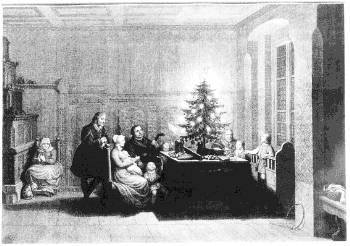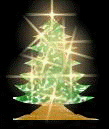
 Christmas Trees: Christmas is almost upon us, so,
if you haven't already heard it, it's time for the annual lecture on the
horrors of crass commercialism and maudlin sentiment. Well, it may be time,
but this ain't the lecture. If buying and/or giving of expensive gewgaws
and doohickeys makes you feel good, you just go ahead and do it -- just
make sure you don't forget to put me on your list. (Definitions: gewgaws
are little things that are pleasing to the eye; doohickeys, as the name
implies, actually have to "do" something, even if it's not worth doing.)
Christmas Trees: Christmas is almost upon us, so,
if you haven't already heard it, it's time for the annual lecture on the
horrors of crass commercialism and maudlin sentiment. Well, it may be time,
but this ain't the lecture. If buying and/or giving of expensive gewgaws
and doohickeys makes you feel good, you just go ahead and do it -- just
make sure you don't forget to put me on your list. (Definitions: gewgaws
are little things that are pleasing to the eye; doohickeys, as the name
implies, actually have to "do" something, even if it's not worth doing.)
But simpler days, sans shopping, clearly have their attraction. Many of us think of the Dickensian Christmas -- as described in "A Christmas Carol" and celebrated in Merry Olde England in Victorian times, when some people seemed to be too poor to enjoy the holiday unless it was subsidized by renovated Scrooges -- as the simpler "good olde days". But those days were actually fairly recent in the Christmas scheme of things, and they also weren't appreciably simpler. That extra "e" at the end of "olde", by the way, is an Olde German modifier suffix that has the basic meaning of "nostalgic for white Anglo-Saxons".
If you really want simple and old, you have to go much further back. Everyone knows that the ancient Romans hung evergreens around their domus or their insula apartment during the Saturnalia. Ancient Egyptians brought in palm branches on the shortest day of the year (December 21st on our calendar, but December 25th on the Ancient Roman Calendar) to symbolize Ra's victory over death. Ancient Chinese also brought in greenery at the same time of year. Druids, who were in the British Isles, France, and Northern Germany, meanwhile, were worshipping oaks, holly, ivy, and especially mistletoe. At least they did until Saint Boniface, the British founder of the great Monastery at Fulda, chopped down (or felled with a single punch, in more imaginative versions) Thor's mighty sacred oak at Geismar, Germany, near Frankfurt, around 722 AD. Boniface became the patron saint of Germany and the Netherlands, and the small fir-tree that supposedly alone survived the tumult of the falling oak became, eventually, the Christian Christmas tree.
By that time, the great controversy about when to celebrate Christmas, which is much to complex to go into here, had already been settled. (If you really must know everything, the "official" story of how Christmas got to be December 25 -- published by the church that made the decision -- is at http://www.newadvent.org/cathen/03724b.htm. Suffice it to say that there is documentary evidence that, in the early church, some Christian community somewhere celebrated Christmas in every month of the year. Settling on December 25 was thus a lot more than just some third of fourth century Pope trying to drown out the Saturnalia/Sol Invictus clatter with Christian hymns.)
By the Middle Ages, December was a time when Christians hung red apples on trees, mostly firs, all over Europe as a symbol of the feast of Saints Adam and Eve, which was celebrated on December 24. The trees were apparently originally used for props in "Miracle Plays" to represent that Eden apple tree that got the first couple into so much trouble. Gradually, such trees moved from local stages to house vestibules, but they were for the 24th, not for the 25th. Remaining Druids, meanwhile, continued to hang "golden" (i.e., gold painted) apples on oaks.
The first known references to a
fir tree decorated specifically for Christmas were in what later became
the Baltic state of Latvia around 1510. Evergreen trees decorated with
artificial roses were burned in the squares of Riga and Reval by dancing
members of local guilds as after dinner entertainment on Christmas Eve.
By 1531 there was a thriving market for Christmas trees in Strasbourg (now
in France, but then in a German province). In the same Alsace province,
there were soon laws limiting the size and amounts of evergreens that could
be put in a house. It's not clear whether these were conservation or fire
prevention rules. The red apples of the Adam and Eve tree were retained,
along with figures of Adam, Eve, and the serpent. But artificial flowers
and flat reeds (symbolizing salvation through Communion) were soon added.
In some areas, the trees were hung upside down from the ceiling. No one
seems to know why.
|
The
Catholic Church originally was hostile to these "pagan" customs, and became
even more so after German Lutherans claimed the Christmas tree tradition
as their own. Luther himself was associated with Christmas trees decorated
with small candles. His was supposedly the first illuminated Christmas
tree, unless you count the Latvian tree burners. Much later, in 1845, the
legend was solidified when Carl August Schwerdgeburth painted a supposed
scene of the reformer's family around a candle-lit tree. Although Luther's
candle-lit tree can't be verified, he was a great advocate of Christmas
celebrations. He wrote several Christmas hymns -- but not "Away in a Manger",
which first surfaced in an American hymn book in 1885 and was first said
to be Luther's two years later.)
|
 |
But after condemnation during the Catholic "counter-reformation", trees gradually found their way back into Catholic homes and even into their churches. It was always more of a northern European custom than a southern one, but that may have been because the traditional triangular trees were more common in the north.
Decorations: Other decorations soon joined the apples and breads and flowers mentioned above on the drooping fir boughs. The Germans added "tinsel" and tinsel twists (first made of tin) in the mid-16th century, although some sources say both were pirated from secret French methods of making lame for elaborating military uniforms. In the 1850's, the German Lauscha Company, based in Thuringia, introduced shaped glass bead garlands and larger blown glass balls and shaped ornaments. They followed with the "Rauschgoldengel" -- the gilded tin angel -- which, now, in many cases mutated into plastic, perches atop trees worldwide. The Lauscha ornaments became popular in the UK (1870s) and US (1880s) and were standard tree decorations until World War 1 cut off Lauscha supplies. One of the great US department store chains was based on the importation of Lauscha ornaments, starting with a few ornaments hand-carried from Thuringia by F.W. Woolworth. The first artificial trees, made of goose feathers, came into use in the 1880s in Germany when folks started worrying about the declining fir tree census. In 1882, Edward Johnson, a colleague of Thomas Edison, embellished a tree with a string of 80 small hand-made electric light bulbs, and within ten years, Christmas light strings were in mass production. In the 1930's the first artificial "brush" trees -- twisted wires with green bristles -- were made by the American Addis Brush Company made on the same machines as their popular toilet brushes. Many other artificial tree fads followed: especially memorable were the pink "flocked" trees and shiny aluminum ones, often rotating and lit with multi-colored spotlights, of the 1950s and '60s. "Natural" trees are now back in fashion thanks to massive "tree farms" where firs, spruces, and pines are purpose-grown and shaped for the Christmas market.
American trees: Other cultures have their own tree-decorating traditions, many of which have become "American" as new immigrant groups arrived. There are conflicting claims about how Christmas trees came to the US. Descendants of German settlers in southern Pennsylvania, especially around Lancaster (which sometimes claims to be the US Christmas Capital) say their ancestors had Christmas trees in the colonial period. And Hessian mercenaries had their own decorated trees during the American Revolution. A Christmas tree is mentioned in the 1820 diary of Mathew Zahn of Bethlehem, Pennsylvania. Nonetheless, Williamsburg, Virginia, claims that the first decorated tree in the US was set up there by one Charles Minnegrode in 1842. The distinction may be between outdoor and indoor trees. In 1851 Mark Carr, who opened the first documented retail tree lot in the US, hauled two sled-loads of trees from the Catskill Mountains into New York City. The US has had an official "National Christmas Tree Lighting Ceremony" on the White House lawn since Calvin Coolidge first pulled the switch in 1923.
The earliest record of a Christmas tree in England is of the one set up for Queen Charlotte of Mecklenberg-Strelitz, wife of King George III, in 1800. The member of the royal family who really made the Christmas tree popular in England, however, was Prince Albert of Saxe-Coburg-Gotha, the husband and cousin of Queen Victoria. He had a tree brought into Windsor Castle in 1841 for the Royal Family, and in 1848 The Illustrated London News printed a full-page illustration of the Prince Albert's tree. The next year every London family of note (and many of the un-noted) had a tree. Trees soon spread throughout the Empire, and in the outer fringes they were often topped with the British flag.
There are gazillions of Xmas Internet sites, many of which have the origin of Xmas trees and other good Xmas stuff. (The X for Christ in "Xmas", by the way, is a very early Christian tradition, not modern laziness.) Some of the many sites consulted for this article are:
Medieval Christmas, About.com: http://historymedren.about.com/library/weekly/aa120897.htm and http://historymedren.about.com/library/blxmas.htm
Christmas Legends and stories: http://www.christmas-stories.com/christmas-legends.php and http://www.nicksspot.com/christmas/ch00010.html
Saint Boniface: http://www.stboniface.org.uk/whowas.htm
Christmas in German Europe: http://www.german-way.com/german/christmas.html
UK Christmas from Christmas Archives: http://www.christmasarchives.com/england.html (Use the "T of C" link at the upper left for much more Xmas stuff.)
Christmas History, Customs, and Folklore from About.com: http://urbanlegends.about.com/cs/christmaslore/ (where you will also find a link to the Donner/Donder controversy)
P.S.: Luther wrote 37 known Chorales. Though not, as some would have it, the originator of this popular form of participation singing, there is no doubt that he established the practice of congregational singing of the Mass as a regular means of worship. For Luther's musical reforms, see: http://classicalmus.hispeed.com/articles/luther.html
Find out about the Roman Saturnalia at http://www.mmdtkw.org/VSaturnalia.html.
For information on the good Italian Christmas Witch, la befana, go to http://www.mmdtkw.org/VBefana.html, which also has a link to the Italian origin of la Piñata.
For information on the history of the "Nativity Scene"/creche/presepe go to http://www.mmdtkw.org/VPresepe.html.
Go to http://www.mmdtkw.org/Veneto2002.html for other articles.